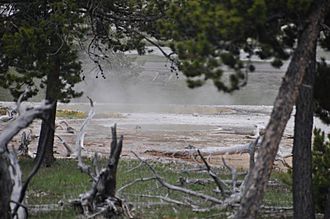Baby Daisy Geyser facts for kids
Quick facts for kids Baby Daisy Geyser |
|
|---|---|

Baby Daisy Geyser is the smaller pool in front, while the larger pool in back is Baby Splendid Geyser.
|
|
| Location | Upper Geyser Basin, Yellowstone National Park, Teton County, Wyoming |
| Coordinates | 44°28′54″N 110°51′02″W / 44.4817959°N 110.850667°W |
| Elevation | 2,220 metres (7,280 ft) |
| Type | Cone geyser |
| Eruption height | 20 to 25 feet (6.1 to 7.6 m) |
| Frequency | 33 to 39 minutes |
| Duration | 2 to 3 minutes |
| Temperature | 60 °C (140 °F) |
Baby Daisy Geyser is a fascinating geyser located in Yellowstone National Park in the United States. It's part of a famous area called the Upper Geyser Basin, which is home to many amazing hot springs and geysers. Baby Daisy is also part of a smaller group of geysers known as the Old Road group.
Contents
What is Baby Daisy Geyser?
A geyser is a natural hot spring that shoots out hot water and steam from time to time. Baby Daisy Geyser is one of these amazing natural wonders. It's known for its unique way of erupting water into the air.
Where is Baby Daisy Geyser Located?
You can find Baby Daisy Geyser in the Upper Geyser Basin of Yellowstone National Park. This park is mostly in Wyoming, a state in the western United States. The geyser is specifically located in Teton County, Wyoming. Yellowstone is famous for its many geothermal features, like geysers and hot springs.
How Does Baby Daisy Geyser Erupt?
Baby Daisy Geyser doesn't erupt all the time. It has periods when it's very active, and then it might go quiet for several years. For example, it was very active from 2003 to 2004.
When it does erupt, it's quite a sight!
- The eruptions usually last for about two to three minutes.
- After one eruption, you might wait about 33 to 39 minutes for the next one.
- The water can shoot up to a height of 20 to 25 feet (about 6 to 7.6 meters) into the air.
Why is it Called Baby Daisy?
This geyser got its name because its eruptions look a lot like those of a larger, more famous geyser called Daisy Geyser. Baby Daisy's eruptions are just on a smaller scale. Both geysers shoot water out at a similar angle, about 30 degrees from straight up. This makes them look like they are related, even if one is a "baby" version!

